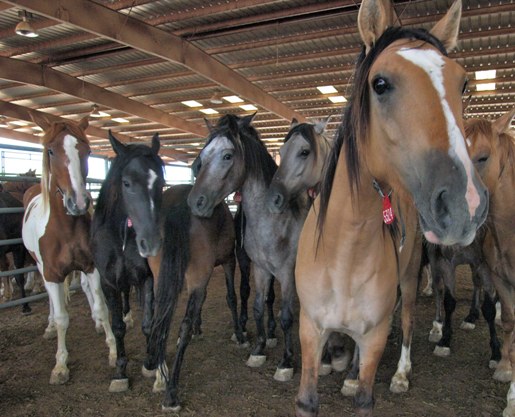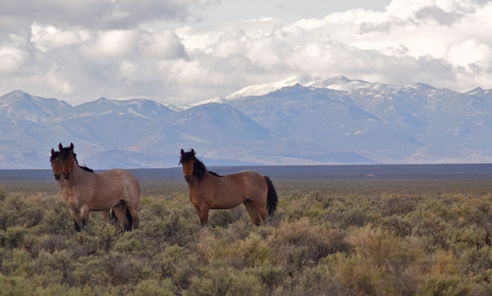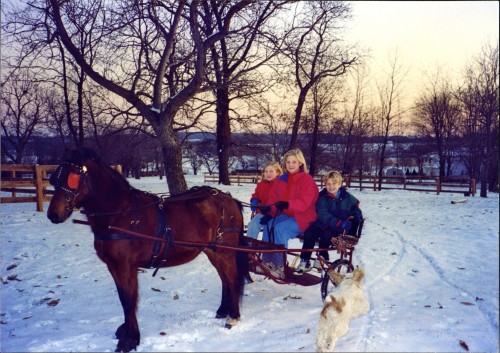 Two summers ago I did something reckless: I went to a wild horse and burro auction in Bernalillo, New Mexico. I managed not to place any bids, but I fell in love many times over. Nothing is more beautiful than a wild mustang and these were going for a song.
Two summers ago I did something reckless: I went to a wild horse and burro auction in Bernalillo, New Mexico. I managed not to place any bids, but I fell in love many times over. Nothing is more beautiful than a wild mustang and these were going for a song.
The 50 yearlings, mares and geldings were separated into five pens: two pens of yearlings, one of mares, one of geldings and one of donkeys. The yearlings were the calmest. Most had been rounded up with their mothers the winter before and weaned over the summer. Having spent so little time on the range, they were the most used to corraled life.
The mares and geldings had a different, dangerous energy. The majority of the adult horses were between two and four years of age and the auctioneer warned most were on “the wilder side of wild”. Both pens were given to panicking; one horse would spook, setting off the others in a swirling, dusty mass of flared nostrils, white eyes and pounding hooves.
The BLM officials gave the crowd about an hour to check out the horses in the corrals before starting the bidding. At each pen, interested buyers would call out the number of the animal they wanted – numbered tags were secured on a rope around each horse’s neck – and the bidding would start at $125. There were few battles; most animals went for the base price or five to ten dollars more, a small price to pay for a living, breathing piece of the ever shrinking Wild West.
 Mustangs have long been a symbol of the Great American West, but these days less and less free space is being allotted to them on the open range. Horses grazing on the 264 million acres of Bureau of Land Management land in the West must compete with cattle for grass and with coal, natural gas and oil extraction operations and wind farms for space.
Mustangs have long been a symbol of the Great American West, but these days less and less free space is being allotted to them on the open range. Horses grazing on the 264 million acres of Bureau of Land Management land in the West must compete with cattle for grass and with coal, natural gas and oil extraction operations and wind farms for space.
Mustang critics are quick to point out that horses are not native to North America, at least not anymore: the last truly indigenous horses died out around 10,000 years ago, likely due to climate change at the end of the last Ice Age and possibly compounded by over hunting by newly arriving humans.
But North America must also be acknowledged as the original home of the horse: Equus evolved here and thrived here for more than 57 million years, spreading across the Bering land bridge to Asia and the rest of the world. If detractors want to call horses invasive, they have to acknowledge that beef cattle are too, not to mention Homo sapiens.
Spanish Conquistadors first reintroduced the horse to North America in the mid-1500’s and escaped animals gradually began repopulating the continent. Native Americans began catching, raising and riding horses in the early 1600’s, starting in the Southwest and spreading east into the Plains. Over the next 300 years, freed horses belonging to traders, explorers, settlers, pioneers and ranchers added to the wild herds.
In 1971, Congress passed the Wild Free-Roaming Horses and Burros Act in an effort to protect “the living symbols of the historic and pioneer spirit of the West”. The new laws made it illegal to poison or shoot a wild horse or burro and ensured that the animals would be allowed to remain on the land in “manageable” numbers.
Defining “manageable numbers” is where things get tricky. With few natural predators – only mountain lions and wolves hunt horses – mustang populations are constantly on the increase. With the fecundity of rabbits, herds can triple in size every 6 to 8 years if left unchecked.
At last count, roughly 33,000 wild horses roam the West, more than half of those in Nevada and the rest mainly in Montana, Oregon, Idaho, Utah and Wyoming. The Bureau of Land Management (the agency charged by Congress with managing mustangs) claims that rangelands can only support around 23,000 horses. So what to do with the 10,000 surplus animals?
The BLM’s primary solution has been to round them up by helicopter and offer them for adoption. Adopting a wild mustang is easy: all you need is a 20 X 20 foot enclosure with a minimum 6-foot high metal or wooden fence, an attached three-sided shelter, a record clean of animal abuse or neglect convictions and between $25 and $125 for the adoption fee.
The hard part comes when you bring your very own mustang home. Animals offered for adoption are usually only a few months off the range and have not been handled except for basic veterinary care including vaccinations and geldings. These are truly wild creatures and it may take months of daily work to tame them for handling and years to train them for riding. Every case is different and some trainers are more gifted than others, but in general, turning a wild horse into a trusty steed is a long, difficult and potentially dangerous road. Someday, I’d love to adopt a mustang myself, but the fact is, there are a limited number of horse people with wherewithal to handle, care for and train wild horses.
Currently more than 45,000 mustangs are being kept indefinitely at holding facilities, the majority in Oklahoma and Kansas. The BLM does not euthanize healthy animals, though they do put down the sick, injured and old “in the most humane manner possible”. Mustangs have been sent to slaughterhouses in the past, and may be again in the future, but for now, the practice remains taboo.
A new study, published in Science in August, breaks down the costs of keeping so many horses in holding pens for several decades – hardy mustangs can live 25 to 30 years. Annual minimum costs for food and upkeep for one horse run just over $1,000 and with thousands of horses being rounded up and installed in holding pens each year, the BLM’s mustang program quickly adds up to a billion dollars by 2030, clearly not a sustainable solution.
So what else can be done? Easy answers are as hard to wrangle as a wild mustang. Contraceptives seem to be working for the small herds of wild ponies on Assateague Island in Maryland, but the drugs are more effective when injected by hand (as opposed to darts) and mustangs don’t exactly line up for shots. The highly controversial helicopter round ups would have to continue and every mare would have to be caught and injected every three years.
Still, each mustang that stays on the range saves $16,110 in maintenance costs over 15 years, the average life expectancy of horses kept in holding pens. And the numbers add up quickly: every 62 horses left on the range saves $1 million. So it seems, for now, that cattle might just have to make room for more mustangs.
At the auction I attended, 8 horses and 5 donkeys were adopted. If I had been feeling rash, I would have bid on this one blue roan filly. Rounded up the previous winter in Utah, she was skittish but curious and a natural ham. I looked into her big brown eyes and fantasized about raising my hand, writing a check and making her mine. Learning to trust and be trusted by a wild mustang must be among the most extraordinary of all equine adventures.
When I was 12, without my parents’ permission, I bid on and won a driving pony, complete with cart and harness, at an Amish auction. My little red mare “Saturday” and I spent the next ten years driving all the back roads in my hometown. Saturday died in my arms almost exactly a decade later. I didn’t bid on a wild horse that day in Bernalillo, but someday, I will.
____________
Mary Caperton Morton is a Friend of LWON, and a freelance writer and photographer who makes her home on the back roads of North America, living and working out of a tiny, solar-powered Teardrop camper. Follow her travels at www.theblondecoyote.com.
She took the photos herself. Here’s the blue roan filly. Here’s more auction photos.
BLM Adopt A Horse program: https://www.blm.gov/adoptahorse/
Extreme Mustang Makeover: http://extrememustangmakeover.com/

A very informative read. I hope and pray that the wild horses and burros are never again sold for slaughter. The thought is appaling.
Very interesting and educational article. I’m not sure that I could actually attend the auction and resist plunking down $125!! 🙂